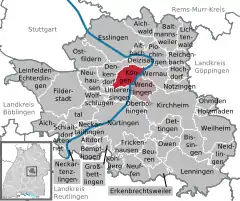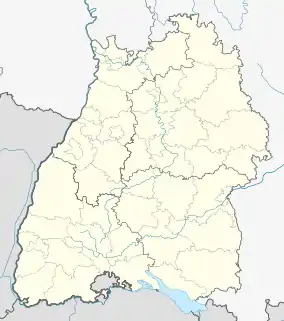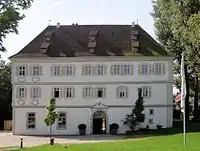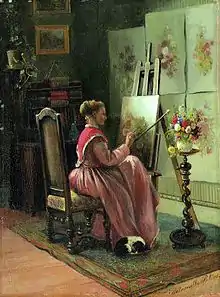Köngen
Köngen is a municipality in the district of Esslingen in Baden-Württemberg in Germany. About nine kilometers from the district city Esslingen am Neckar and about six kilometers away from Nürtingen. It is part of the Stuttgart Region and the european Stuttgart Metropolitan Region.
Köngen | |
|---|---|
 Coat of arms | |
Location of Köngen within Esslingen district  | |
 Köngen  Köngen | |
| Coordinates: 48°40′55″N 9°22′0″E | |
| Country | Germany |
| State | Baden-Württemberg |
| Admin. region | Stuttgart |
| District | Esslingen |
| Government | |
| • Mayor | Otto Ruppaner |
| Area | |
| • Total | 12.52 km2 (4.83 sq mi) |
| Elevation | 281 m (922 ft) |
| Population (2019-12-31)[1] | |
| • Total | 9,819 |
| • Density | 780/km2 (2,000/sq mi) |
| Time zone | UTC+01:00 (CET) |
| • Summer (DST) | UTC+02:00 (CEST) |
| Postal codes | 73257 |
| Dialling codes | 07024 |
| Vehicle registration | ES |
| Website | www.koengen.de |
Geography
Geographical location
Köngen is located on the left side of the river Neckar on the western slopes of the Neckar valley.
Neighboring communities
Adjacent communities are in northern Deizisau, northeast Wernau (Neckar), southeast Wendlingen, south Unterensingen and west Denkendorf (all Esslingen district).
Municipality arrangement
The municipality includes the village Köngen, the yards Birkenhöfe, Buchenhöfe, Erlenhöfe, Kempflerhöfe, Lerchenhof, Riedhöfe, Rothöfe, Seehof, Talhof and Wangerhöfe and the house Altenberg.[2]
History
Ancient History
Köngen is in the area of the Roman settlement "Grinario" that was built around 100 a. Chr around a Roman Castra. Grinario was the endpoint of the Roman road "Neckar-Alb-Aare" which originated in Windisch (Switzerland). In 260 the place was destroyed by the Alemanni and the Romans were expelled.
Middle Ages
The Alemanni place was first mentioned in 1075 in a document of the Hirsau Abbey. In 1336 the lords of Hohenberg sold the village to Albrecht von Aichelberg. In 1382 the Herrschaft of the lords of Thumb von Neuburg attained it, who relocated their residence from Graubünden to Köngen in 1430. Hans Friedrich Thumb promoted early the Reformation; already in 1527 was therefore preached Lutheran in Köngen, this is seven years before Duke Ulrich penetrated in 1534 the reformation in Württemberg.[4]
Modern history
Around the year 1600 about 900 people inhabited the village. During the 17th century Köngen suffered from several outbreaks of diseases and war violence. From 1609 until 1611 there was a first plaque outbreak, the second one happened in 1627. About one third of the population died from the disease. Over one hundred inhabitants were killed by marauding troops of the victorious emperorer after the Battle of Nördlingen in 1634. The number of 1,000 inhabitants was only passed during the first half of the 18th century. 1739 Köngen became part of Württemberg after the previous owners (Thumb von Neuburg), had been working for Württemberg already for more than two hundred years at this point. After the foundation of the Kingdom of Württemberg in 1806 until 1808 Köngen was seat of an Oberamt. During the consolidation phase of the new württembergian administration it was allocated to the Oberamt Esslingen, which was as part of the "Kreisreform" during the National Sozialist time in 1938 changed and enlarged to the district of Esslingen. Because Köngen became part of the American occupation zone after the second world war, it belonged to the state of Württemberg-Baden, founded in 1945 which in 1952 merged into todays state of Baden-Würtemberg.
Religion
Since the reformation Köngen has been mostly Lutheran. Only since 1953 there has been a catholic church again. The new building became necessary because of the relocation of many catholic Heimatvertriebene ("homeland expellees"). Furthermore there are a United Methodist Curch and since 1924 a New Apostolic Church.
Population
The populations are estimates, results of the Censuses in Germany (¹) or official updates of the statistical state office (only main residence).
|

Politics
Mayors
- 1945–1946 Wilhelm Zaiser
- 1947 Gustav Bracher
- 1947–1982 Erwin Rath
- 1982–2014 Hans Weil
- since 2014 Otto Ruppaner
Municipal Council
The municipal council in Köngen has 18 members. The local election on May 26. had the following official results.[5] The municipal council consists of the elected honorary members of the council and the mayor as chairperson. The mayor is eligible to vote.
| Parties and Voting Blocks | %2019 | Seats2019 | %2014 | Seats2014 | |
| FW | Freie Wähler | 41,46 | 7 | 39,87 | 7 |
| CDU | Christlich Demokratische Union Deutschlands | 27,21 | 5 | 29,65 | 5 |
| SPD | Sozialdemokratische Partei Deutschlands | 16,52 | 3 | -- | -- |
| GRÜNE | Bündnis 90/Die Grünen | 14,81 | 3 | -- | -- |
| SPD/GRÜNE | Sozialdemokratische Partei Deutschlands–Bündnis 90/Die Grünen | -- | -- | 30,48 | 6 |
| Total | 100,0 | 18 | 100,0 | 18 | |
| Voter turnout | 65,70 % | 53,3 % | |||
Heraldry
Blazon: "In blue a silver bell".
Köngen has the largest bell of its Peter-und-Paulskirche in its coat of arms. This bell is supposed to have been burried during the Thirty Years' War for fear of marauders. When the war was over no one was alive anymore who knew the hiding place. The lost bell was then uncovered from the ground, according to legend, by pigs. Since then the bell is named „Sauglocke“ (sow bell).
Sister cities
Köngen maintains partnerships to:
- Taucha in Saxony-Anhalt and
- Český Brod in the Czech Republic.
Economy and Infrastructure
Transportation
Köngen is connected to the national road network through the federal road B 313 and the Bundesautobahn 8. The bus line 151 connects the town to the nearby train station of Wendlingen am Neckar. From there trains run towards Tübingen and Stuttgart, the S-Bahn runs towards Stuttgart and Kirchheim unter Teck.[6].
Since 2016 an additional citizens' bus runs in Köngen on 3 weekdays and since December 2016 the new Express bus X10 creates a direct connection to Stuttgart Airport and the train station Kirchheim unter Teck.
Education
In Köngen there are a primary and secondary school, (Burgschule) and a further primary school, the Mörikeschule, named after Eduard Mörike. In addition, there are seven kindergarten in Köngen. The library of the municipality Köngen is in the attic of the tithe barn and has a stock of around 15,000 media.[8]
Culture and Points of Interest
Points of Interest
- Köngen is located at the Neckar line of the Obergermanischen Limes. In the town the 23 km long Lautertal Limes line splits off from the Neckar line, which ends at the Alblimes at Donnstetten. This straight path had already been known as Sibyllenspur for a long time prior to its interpretation as Limes in 1976.
- Köngen is start and end point of the scenic route Römerstraße Neckar–Alb–Aare.
- Notable are two replicas of Jupiter Columns:
- Replica of the Jupiter Column from Hausen an der Zaber on top of the roundabout at the Plochinger Straße.
- Nachbildung der Jupite Column from Walheim in front of the reconstructed guard tower in the southeast corner of the roman park.
- Roman Museum and Archeological Park Köngen. The Kastell of Köngen has been a cultural monument since 1974 and is the only Castra along the entire Neckarlimes not being over built after the war.[9] It is as an military camp at the roman Limes part of the UNESCO World Heritage since 2005. The corner tower of the old garrison was found in 1885 by general Eduard von Kallee[10] and already reconstructed in 1911.[11]
- The Köngener Schloss was first constructed in 1392 as a castle by the local lord, the Free Imperial Knight Hans Thumb von Neuburg. The Neuburg still exists today as a ruin north of Chur in Grisons. Already in 1398 the castle was expanded to a water castle with four wings. In 1520 the castle was heavily damaged by troops of the Swabian League. Therefore an almost entirely new construction was built after 1520. The castle changed into a Renaissance chateau. During this construction the Rittersaal was expanded in 1538, which has survived almost unchanged up to today. The changes took almost the entire 16th century. Heinrich Schickhardt mentioned in his catalogue that he had built a gate house at the castle around 1600. It was torn down together with two wings during the changes made by Jakob Friedrich Weishaar. Weishaar bought the estate in 1825 and let it be changed according to his needs. Up to the 1930s it was a place for cultur. Here the known „Bund der Köngener“ was established, whose member was amongst others Gerhard Gollwitzer. The painter Christian Mali and the dutch-german painters family Peters stayed often in the chateau. During the last few years Frescos from the 18th century on the eastern wall of the Rittersaal have been uncovered and restored. They show figures out of antique mythology and history.[12]
- The foundation stone for the protestantist Peter- und Pauls-Kirche was layed in 1502 by the builder Stefan Waid. After his death in 1504 it was finished by builder Merx from Esslingen until 1512[13]. Under a chiffs: 23,0 × 12,1 Meter. Unter a king post a painted renaissance beam ceiling has been hnaged up since 1613. The western tower was constructed in 1724. The originally late Gothic carved altar was remodeled in 1614. The architects Kreuz + Kreuz from Stuttgart conducted the latest internal renovations in 2011.[14] Features:[15] The sculptor Martin Scheible from Ulm created a pulpit with carved reliefs in 1953 (Topics: the works of mercy); the renaissance pulpit ceiling remained. The glas artist Wolf-Dieter Kohler from Stuttgart designed the glas paintings of the three choir windows in 1958 (left: three parables; middle: returning Christ, Angel, Michael; right: three further paraples).
- The cultural heritage listed Ulrichsbrücke over the Neckar river was constructed according to plans by Heinrich Schickhardt between 1600 and 1602. It sits at the same location as an earlier roman bridge.[16] Due to impoundment downstream the pilars of the bridge are nowadays partially under the water level.
 Replica of the Jupiter Column from Hausen an der Zaber in Köngen
Replica of the Jupiter Column from Hausen an der Zaber in Köngen Roman Museum Köngen
Roman Museum Köngen Köngener Schloss
Köngener Schloss Protestant Peter- and Pauls-Church
Protestant Peter- and Pauls-Church The Ulrichsbrücke built in 1602 over the Neckar
The Ulrichsbrücke built in 1602 over the Neckar Alte Vogtei
Alte Vogtei
Regular Events
- Pfingstmarkt (Pentecost market on pentecost monday)
- Autumn market
- Culture days
- weekly market
- Pentecost music festival of the Musikverein Köngen e. V.
- 3k-Festival[17]
Notable People
Sons and daughters of the city
- Konrad Thumb von Neuburg (1465-1525), hereditary marshal of Ulrich, duke of Württemberg
- Gustav Adolf Boley (1835-1891), entrepreneur and inventor
- Nicolai Theilinger (* 1992), Handball player
Other personalities who are associated with Köngen

- Daniel Pfisterer (1651–1728), documented the live in Köngen both in its positive and negative aspects in many pictures and rimes
- Jakob Friedrich Weishaar (1775-1834), Württemberg politician, president of the Chamber of Deputies, lived from 1823 until his death in Köngen
- Eduard Mörike (1804-1875), was from May until December 1827 vicar with pastor Nathaniel Gottlieb Renz
- Eduard von Kallee (1818–1888), discovered the military camp of the Kastell Köngen in 1885 due to military considerations
- Christian Mali (1832–1906), Animal, Landscape and Genre painter, during his life - especially in his last years - the artist spend much time at the Köngener Schloss
- Anna Peters (1843-1926), painter, lived and worked from 1894 to 1924 again at Schloss Köngen
- Pietrosella Peters (1848-1924), painter, lived and worked from 1894 to 1924 again at Schloss Köngen
- Otto Rennefeld (1887–1957), poet and anthropologist, from 1946 in Köngen
- Ilse Rennefeld (1895–1984), anthropologist doctor, from 1946 in Köngen
- Else Klink (1907-1994), from 1935 to 1991 Head of Eurythmeum Stuttgart, lived in Köngen
Literature
- Wurster, Otto: Eßlinger Heimatbuch für Stadt und Umgebung. Eßlingen 1931. Darin: Köngen (p. 27–281).
- Der Landkreis Esslingen. Hrsg. vom Landesarchiv Baden-Württemberg in Verbindung mit dem Landkreis Esslingen, Jan Thorbecke Verlag, Ostfildern 2009, ISBN 978-3-7995-0842-1, Volume 2, page 81
- Oertel, Burkhart: Ortssippenbuch Köngen. Vollständige Wiedergabe der evangelischen Kirchenbücher 1588–1808. Köngen: Geschichts- und Kulturverein Köngen 1998 (= Württembergische Ortssippenbücher 39)
- Fastnacht, Kathrin: Köngen. Ein Schloss und seine Herrschaften. Konrad-Verlag, Weißenhorn 2007, ISBN 978-3-87437-530-6.
| Wikimedia Commons has media related to Köngen. |
References
- "Bevölkerung nach Nationalität und Geschlecht am 31. Dezember 2019". Statistisches Landesamt Baden-Württemberg (in German). September 2020.
- Das Land Baden-Württemberg. Amtliche Beschreibung nach Kreisen und Gemeinden. Band III: Regierungsbezirk Stuttgart, Regionalverband Mittlerer Neckar. Kohlhammer Verlag, Stuttgart 1978, ISBN 3-17-004758-2. S. 255–257
- Statistisches Landesamt, Fläche seit 1988 nach tatsächlicher Nutzung für Köngen.
- Baldwin Keck: Die Peter-und Pauls-Kirche in Köngen. Hrsg. von der evang. Kirchengemeinde, Köngen 1981, S. 19.
- Wahlinformationen des Kommunalen Rechenzentrums
- Verbund-Liniennetz auf den Seiten des VVS (PDF; 1,7 MB), abgerufen am 22. Oktober 2010
- Lebensadern einer Stadt, Teil 4 in der Stuttgarter Zeitung vom 6. Dezember 2006 (PDF; 416 kB), retrieved 16. September 2010
- "Archived copy". Archived from the original on 2016-07-31. Retrieved 2016-07-31.CS1 maint: archived copy as title (link)
- „Archäologie in Deutschland“, 2/2006, S. 72
- Konrad Miller: Die römischen Kastelle in Württemberg. J. Weise, Stuttgart 1892, S. 16.
- Dieter Planck: Restaurierung und Rekonstruktion römischer Bauten in Baden-Württemberg. In: Günter Ulbert, Gerhard Weber (Hrsg.): Konservierte Geschichte? Antike Bauten und ihre Erhaltung. Konrad Theiss Verlag, Stuttgart 1985, ISBN 3-8062-0450-0, S. 150
- Elisabeth Maier: Die Rache der Königin Tamiris im Rittersaal. Restaurator Hans Cabanis stellt freigelegte Wandmalereien vor. In: „Eßlinger Zeitung“, 9. März 2010, S. 13.
- "Evangelische Kirchengemeinde Köngen − Peter− und Paulskirche". evkg-koengen.de. Retrieved 2021-02-09.
- Gerald Wiegand und Hans-Peter Duncker: Bauen und Gestalten in der Evangelischen Landeskirche in Württemberg; Stuttgart 2014, S. 4
- Andreas Maier: Impressionen aus der evangelischen Peter- und Paulskirche in Köngen; Hg. Evangelische Kirchengemeinde Köngen am Neckar 2012, einsehbar als PDF siehe , zuletzt abgerufen am 26. April 2019
- Ulrichsbrücke auf den Seiten des Geschichtsvereins Köngen
- "Jugendhaus Trafo | Wir sind eine Einrichtung des Kreisjugendring Esslingen". www.jugendhaus-trafo.de. Retrieved 2016-09-01.
